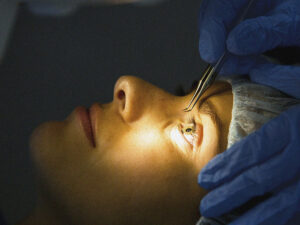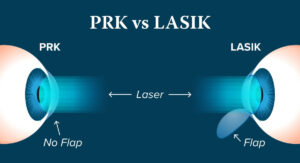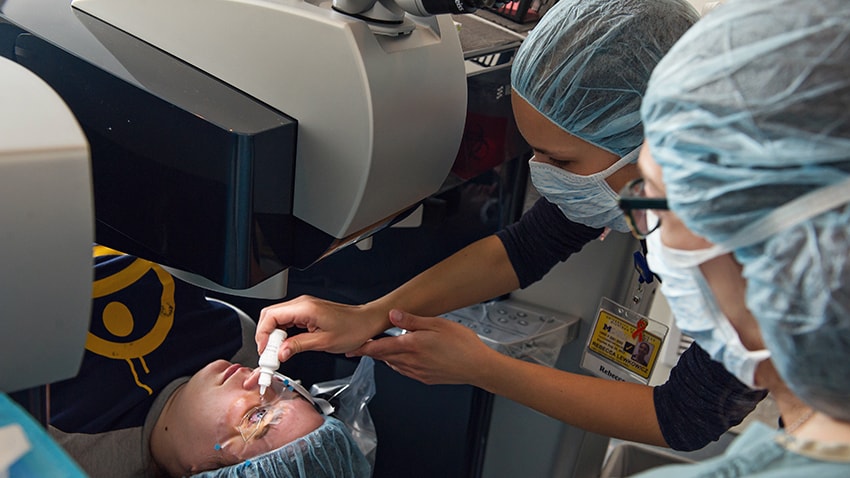If you are considering PRK treatment, you’re not alone. This type of laser eye surgery is one of the most popular procedures in the world. It has helped millions of people achieve clear vision without glasses or contact lenses. But what is PRK exactly? And what can you expect during and after your treatment? In this detailed guide, we will answer all of your questions about PRK eye surgery.
Contents
What Is PRK Eye Treatment?

PRK eye treatment is a type of laser eye surgery that corrects refractive errors, such as nearsightedness (myopia), farsightedness (hyperopia), and astigmatism. During the procedure, a surgeon uses an excimer laser to reshape the cornea – the clear front surface of the eye – so it can properly focus light on the retina at the back of the eye. PRK is an abbreviation for “Photo-Refractive Keratectomy” and is sometimes referred to as Advanced Surface Ablation (ASA).
This type of laser eye surgery has been around for decades and is one of the most reliable eye operations available. It was the first type of laser eye treatment to be approved by the US Food & Drug Administration (FDA). PRK has been used in millions of patients worldwide and offers results that are comparable to other types of laser vision correction procedures, such as LASIK.
Many patients find PRK to be a better option than LASIK because it does not involve cutting a flap in the cornea. Instead, the surface epithelium cells of the cornea are gently removed and then replaced with a contact lens bandage. This means that there is no risk of complications such as flap wrinkles or dislocation, which can occur with traditional LASIK surgery.
What Does PRK Eye Treatment Treat?
PRK eye treatment is an effective method used to treat various eye issues, like:
Myopia
One of the main benefits of PRK eye treatment is to treat myopia or nearsightedness. With this condition, images that far away appear blurry, while those closer up are clearer. PRK reshapes the cornea, helping light focus correctly on your retina for improved vision. When you have myopia, there is a greater likelihood of developing other problems, such as glaucoma and retinal detachment.
Hyperopia
PRK can also treat hyperopia or farsightedness. With this condition, objects up close appear blurry, while further away images are clearer. PRK reshapes your cornea to help the light focus correctly on the retina for clearer vision. In some cases, hyperopia can cause other issues such as retinal tearing or detachment.
Astigmatism
PRK eye treatment is also effective for treating astigmatism. With this condition, the cornea is curved irregularly and causes blurred vision at any distance. PRK reshapes the cornea and helps to bring it back into a more regular shape, improving your vision.
Presbyopia
Finally, PRK can help treat presbyopia, which occurs when you have difficulty focusing on near objects. This often happens with age as the lens of your eyes becomes less flexible and weakens over time. PRK surgery works by changing the curvature of your cornea to help you focus better on near objects.
LASIK v/s PRK Eye Treatment

The differences between LASIK and PRK eye treatments should be considered before deciding on a course of action. Both types of treatments involve reshaping the cornea to improve vision, but LASIK uses a laser to create an incision in the outer layer of the cornea while PRK works by removing a small amount of corneal tissue with a specialized tool.
The main difference between PRK and LASIK is that because no incision is made with PRK, there is less risk of infection or scarring in the long term. Additionally, some people may not be eligible for LASIK due to the thinness of their corneas or other factors, making PRK a viable alternative for those who would otherwise not be able to receive eye care.
PRK Eye Treatment Procedure
The PRK procedure is done in an outpatient setting, under local anesthesia. A special device called a microkeratome is used to carefully remove the outer layers of your cornea, which allows access to the deeper layers of tissue. Then, the surgeon uses a laser to reshape your cornea and correct any refractive errors. This process usually only takes about 10-20 minutes per eye.
The working of the PRK eye treatment procedure can be explained in four stages.
Stage 1: Pre-Operative Examination – Before the surgery, your doctor will perform a thorough examination of your eyes, including measuring your pupil size and taking a corneal scan to get an accurate view of the shape of your cornea. This data is then used to plan the laser parameters for your individualized treatment.
Stage 2: Preparing the Cornea – Anesthetic drops are applied to ensure you feel minimal discomfort during the procedure. The microkeratome device is then used to make a thin flap on tissue at the front of your cornea that allows access to deeper layers for reshaping with a laser.
Stage 3: Laser Treatment– The laser is used to precisely reshape your cornea and correct any refractive errors. This process usually only takes a few minutes. In this stage, the laser applies pulses of light to your cornea, which evaporates tiny amounts of tissue to reshape it.
Stage 4: Post-Operative Care – After the procedure, a bandage contact lens is used to protect your eye and accelerate healing. You must follow all post-operative instructions provided by your doctor for the best results. You may experience mild discomfort or sensitivity during this time. The use of lubricating eye drops can help relieve some of these symptoms.
Overall, PRK treatments offer long-lasting results with minimal risk when performed properly by an experienced surgeon.
Benefits of PRK Eye Treatment
The benefits of PRK eye treatment can be wide-ranging, depending on the individual and their specific situation. However, some can be:
Improves vision: The primary purpose of PRK eye treatment is to improve visual acuity, usually by correcting refractive errors such as near-sightedness, far-sightedness, and astigmatism.
Less invasive: Compared to other types of vision correction surgery, PRK is considered a more comfortable and less intrusive option. It involves no cutting or stitching of the cornea, which can reduce healing time and postoperative discomfort.
Improved self-confidence and independence: After successful PRK eye treatment, those who have been struggling with poor vision may regain their sense of independence. This can lead to increased confidence in various areas such as work or social situations.
Shorter recovery period: Since there is no need for stitches after the surgery, the healing process is much faster and less uncomfortable than with other types of vision-correction surgery.
Risks of PRK Eye Treatment

As with any medical procedure, there are risks associated with PRK eye treatment that must be taken into consideration before undergoing the procedure. Common risks include:
Infection: Infection can occur if proper care is not taken after the surgery. This includes things such as avoiding rubbing or touching the eyes for some time following the procedure and using only sterile solutions to clean them.
Dry eyes: Dry eyes are a common side effect of PRK eye treatment, but this usually resolves within six months following the operation. In some cases, artificial tears may be necessary to help the eyes heal properly.
Light sensitivity: Light sensitivity can occur due to the corneal healing process, but this usually subsides within a few weeks after surgery. Wearing sunglasses when outdoors may help reduce any discomfort caused by this issue.
Reduced night vision: Some individuals may experience reduced night vision temporarily after PRK eye treatment, as the clarity of their vision adjusts to new levels. This should improve over time, however, it is important to be aware of the potential for this side effect before deciding on having the procedure done.
Overall, PRK eye treatment can be an effective way for those with refractive errors or other vision issues to regain clear and comfortable sight. The procedure carries risks just like any other type of surgery, but with proper preparation and care taken after the operation, these risks can be minimized. It is important for those considering PRK to discuss the procedure in detail with their doctor, so they can make an informed decision about whether or not it is right for them.
Can You Prevent PRK Treatment Complications?
Preventing any kind of vision-related complications, including those associated with PRK eye treatment, all starts with the health of your eyes. A comprehensive, annual eye exam is essential for detecting and addressing any issues that might increase your risk of developing problems after surgery.
Additionally, if you have a history of dry eyes or any other ocular conditions that could be exacerbated by the laser procedure, it’s important to talk to your doctor before undergoing PRK eye treatment. Your doctor may suggest preventive measures such as adjusting medications or taking extra steps during the surgery itself to reduce potential side effects.
Finally, even if you’re an ideal candidate for this type of eye treatment and are in good overall health, it’s a good idea to ask your doctor any questions or voice concerns you may have before the procedure. This will enable your doctor to provide personalized advice and ensure that you are fully informed about the entire process, from start to finish.
By taking these precautions, you can reduce your risk of complications and make sure that your PRK eye treatment is as successful as possible. If you have any further questions about this type of laser surgery, don’t hesitate to contact a qualified ophthalmologist for more information. With their help, you’ll be able to determine if PRK is the best option for improving your vision needs.
Conclusion
PRK eye treatment has its benefits and potential risks that must be considered before undergoing this form of vision correction surgery. With its shorter recovery period compared to other options and its potential to improve visual acuity, many individuals have found this procedure beneficial to their quality of life. However, those considering the procedure should speak with a medical professional so they can make an informed decision about whether it is right for them. Ultimately, the decision to undergo PRK eye surgery should be made with all factors in mind, so you can be sure it is the right choice for your eyes and lifestyle.
Cataract surgery is a safe and painless procedure. At MantraCare we have a team of experienced eye surgeons, who will be happy to answer any questions on cataract surgery. Call us at +91-9711116605 for any inquiries.
